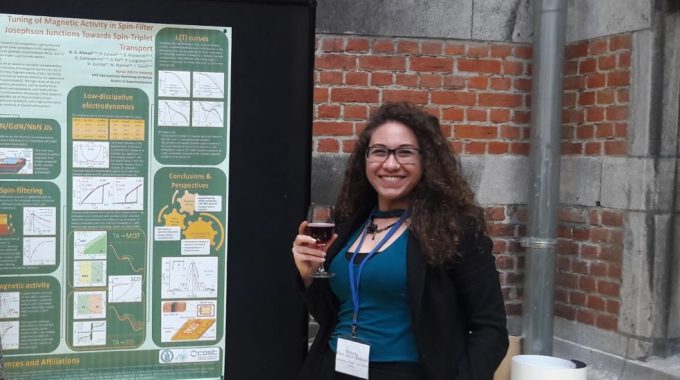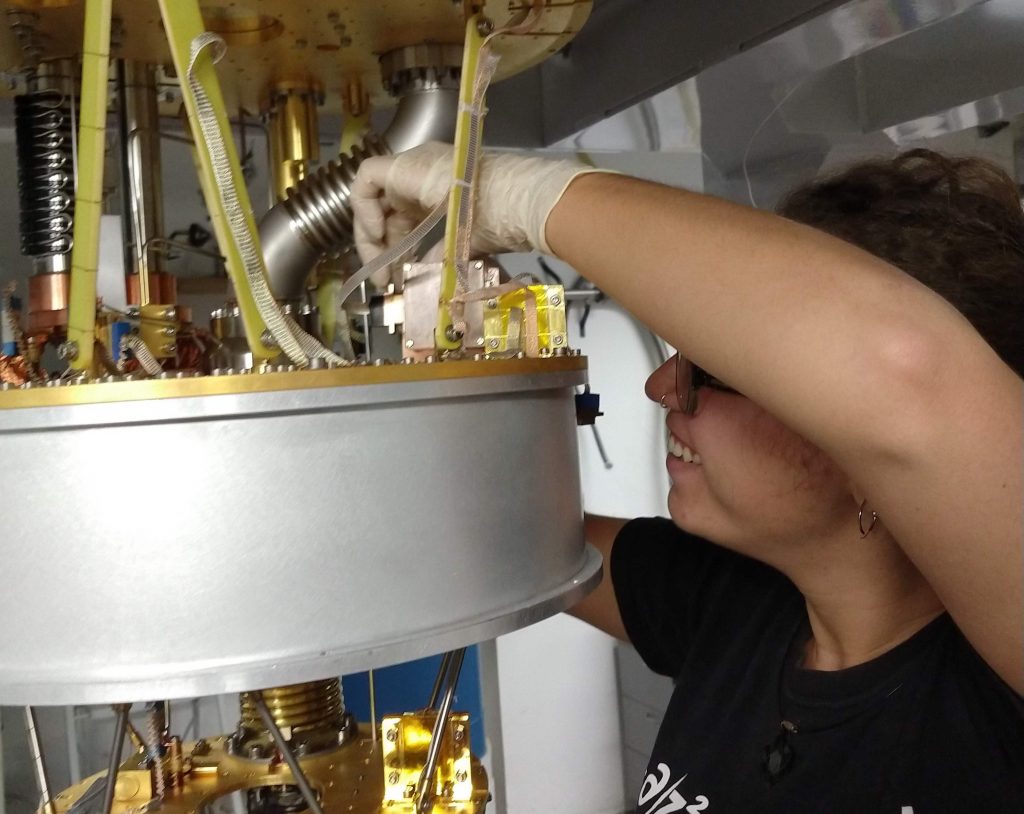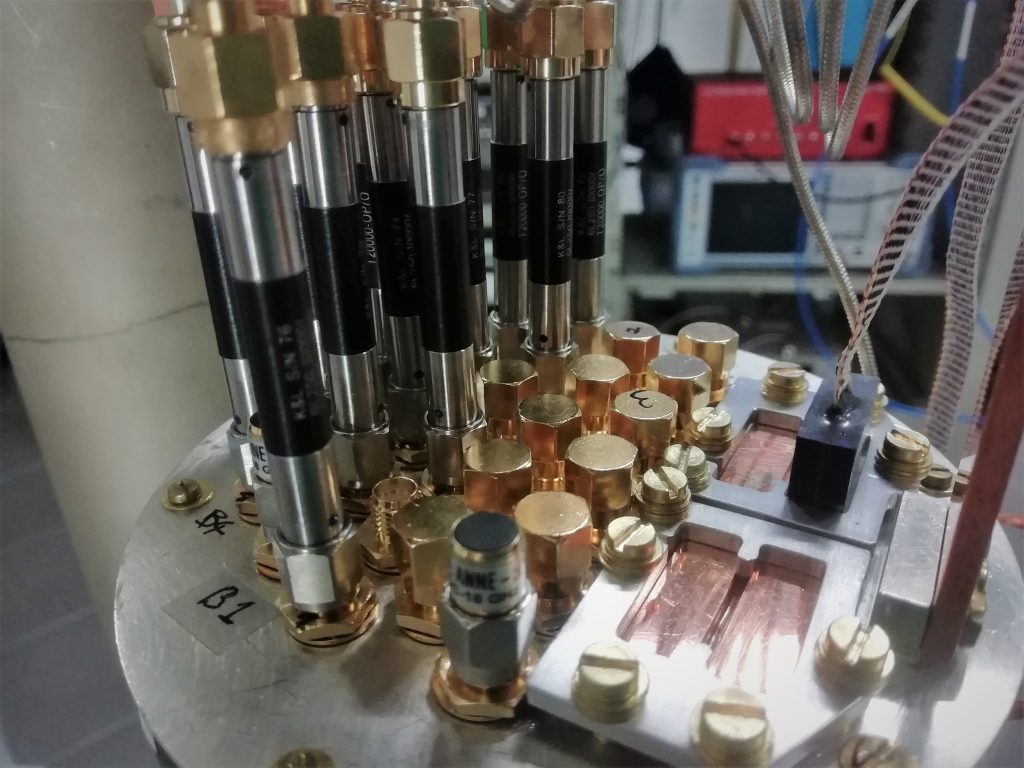
“Hybrid devices are like a sandwich, where you mix more materials with very different properties”, Halima G. Ahmad
Halima Giovanna Ahmad (Italy, 1993) is a postdoctoral researcher in the UniNA group, led by professor Francesco Tafuri at the University of Napoli Federico II, and also works closely with the quantum test division a Seeqc-EU, a quantum computation company.
Q. You just got your Ph.D. with cum laude. How does that feel?
A. I am very happy about it. When you work hard, you usually expect to get something in return. So, achieving a Ph.D. cum laude of course gives you a lot of satisfaction. Especially with the moment, I have had to live through. I started my doctorate in 2018 and the pandemic is the biggest challenge that I faced these years. When our lab was closed last March 2020, and we were locked down, I was totally afraid of not finishing the thesis on time. Fortunately, we were able to return to the lab three months later and I continued the work.
Q. What was your thesis about?
A. My work consists of recreating an atom-like device and learn about its physics. In my case, during the Ph.D. I specifically worked in hybrid devices of superconductors and other materials. A superconductor is a material that has the ability to conduct electricity without losing energy. I usually make devices of superconductor with ferromagnets. These ones are very strong magnets. So, these hybrid devices are like a sandwich, called Josephson junctions, where you mix these two materials with very different physical properties. My job then is to see and study what happens between them and their interactions. The main goal is that one day this knowledge in quantum physics can be useful for future technologies.

Q. And now, what is a day like in your lab?
A. To study our devices we need a cryostat. It’s a big refrigerator with a tube and/or cryogenic liquids that keeps the devices’ samples cold, as superconductors usually only work at very low temperatures. I often need to prepare the system before the measurements. Also, when I started my Ph.D., a new dilution cryostat was mounted. We needed to equip it with low-temperature electronics, and I am still working on this project too.
I particularly remember the first successful measurements that we did within these new dilution refrigerators. Now, the part I enjoy the most of my work is to put my hand on this setup. The idea that there is data you can analyze coming out from a system build by yourself is amazing.
Q. Are there any current technologies in which your research can be applied?
A. For applications nowadays, hybrid devices are used in big systems like magneto encephalograms that can detect very small magnetic fields, like those produced by your brain in your neural system. There are also superconducting quantum computers that I think are up to now very promising devices.
They use qubits instead of bits. The classical bit used in today’s computers has two options, zero or one. That means current passing or current not passing in the electrical circuit of your computer. So there is kind of a limitation. In a qubit, since it’s a quantum system actually made of Josephson junctions, it behaves like an atom. You can be in one state or in another state at the same time. It’s like the Schrödinger cat, you can be alive, dead, and multiple other states. So in a quantum computer, you can increase the power of your algorithm because you can use zero, one, and an infinite superposition of this state.
Q. Is there any chance of getting a quantum smartphone soon?
A. Since I said before, it is necessary to keep hybrid devices very cold. And for now, there is no possibility of carrying a big cryostat in your pocket. But it’s kind of an open field. Maybe one day you can access from your smartphone to a cloud or network linked to these quantum computers, that are hosted with very large cryostats at leading companies. There is some research that we need to follow before we can apply this. My main focus is actually to develop these kinds of little steps before the final application in real life. We don’t know if we can succeed in this, but I think my research is going to be worth that cost.
Q. It sounds like you are having very intense years. Are there any other experiences that have stood out for you?
A. Thanks to a collaboration with SeeQC, a quantum computing company, we had the chance to measure a qubit for the first time here in Italy. It is something that actually very few people in the world can access. So it was thrilling.

Q. Why is it so difficult to see a qubit?
A. It takes very specific conditions. Superconducting qubits are actually made of Josephson junctions. So first, you need a very clean setup with a refrigerator, which protects the qubit from the outside and keeps it at a very low temperature. Building one of these engines is usually expensive and also requires the second condition for seeing a qubit: the researchers.
Even if you have the system, you need experts that know how you can access the state and the physics of the qubit itself. And at the moment, our research field is already quite small and within it, there are few people that can successfully achieve these measurements. They are quite motivations for which I feel it is not accessible for everyone. I can make basic characterization measurements, but I am still learning with the help of the rest of the team.
Q. Are you facing any other challenges as a researcher?
A. Right now collaboration is the most important thing for me. In order to improve your research in academia, you need economical funding. You can only guarantee this by networking. If your research is known by your network, the contribution in your field has more impact, then your chances to get funding increase as your work is more valued. For young researchers like me, being part of a COST action like Nanocohybri gives us the chance to learn how to handle this.
I joined Nanocohybri at the beginning of my Ph.D. My supervisor, professor Tafuri was part of the project and suggested I join at first because they were proposing a lot of conferences, mostly for PhDs and postdocs, that gives you the possibility to tell people what you are doing in the lab, sharing your results. But then I realized it actually enlarges your capabilities, as it has also helped me to start a net knowing different colleagues from different workplaces.
Q. Did Nanocohybri help you in achieving your Ph.D.?
A. I remember that in one of my first conferences during the Ph.D., I was presenting a poster and I was kind of worried about it. Because it was the first time showing those results to somebody. Then, my supervisor told me: “Don’t worry, they are very nice people. If something is totally wrong, they can give you only advice”. He was completely right. It strongly encouraged me to go on and talk around. Others kept asking me really interesting questions and recommending that I read some studies. So this helped me to move my work forward and actually ended up with a paper. I think everything I’ve achieved in these years is a result of a collaboration with colleagues and I really want to be thankful to them.
Author: Lucia Torres @osopolita_
